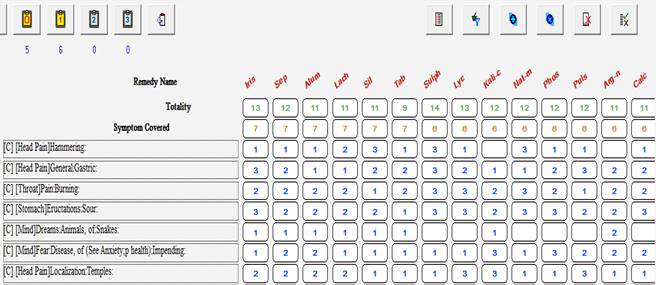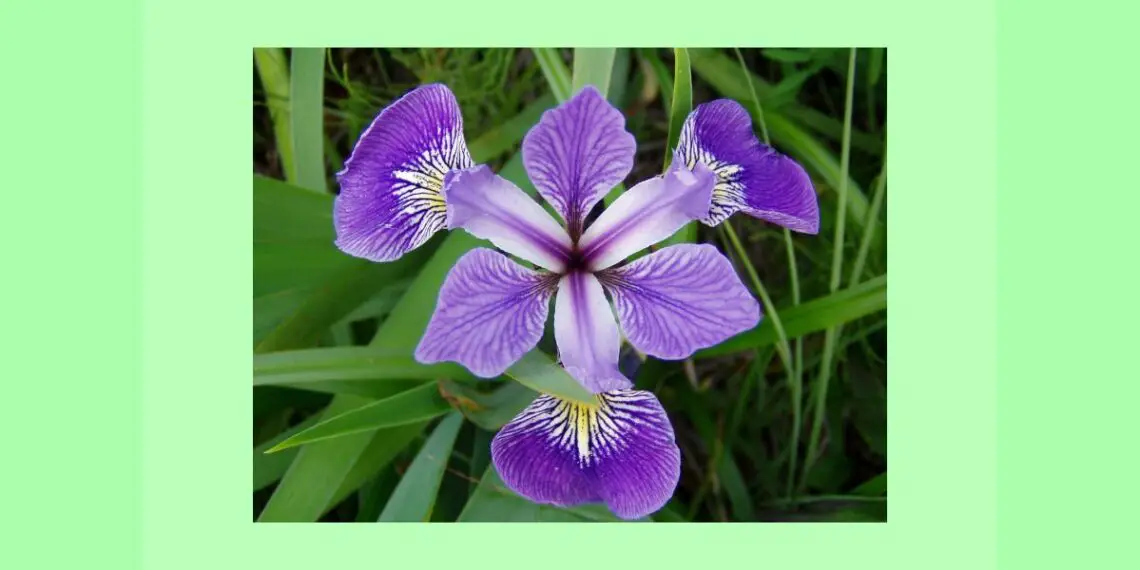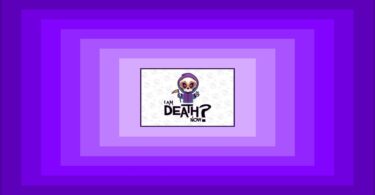Rakesh Gupta1 Vismaya Verlekar2
Abstract: The role of Iris Versicolor as homeopathic remedy in migraines has been demonstrated with the help of two cases. Deriving the homeopathic totality during recurrent distress is a big challenge which can be managed by proper clinical and homeopathic training.
The application of Boeninghausens concept of complete symptom and emphasis on modalities is of great Importance during case taking. Step wise clinical assessment with the help of Migraine Disability Assessment Questionnaire (MIDAS), a 5-item questionnaire designed to evaluate disability within the most recent 3 months is useful for scientific evidence of cure.
Homeopathic remedy reaction evaluation of the case with MIDAS as a Tool helps to cure according to scientific principles of homeopathic system.
Introduction :
Migraine is defined as a triad of paroxysmal headache, nausea and or vomiting and an aura of focal neurological events usually (visual). Patients with all three of these features are said to have migraine with aura “Classical Migraine”.
Those with paroxysmal headache with or without vomiting but no aura are said to have migraine without aura” Common Migraine”. According to World Health Organization, Migraine (ICD 11 classification code for migraine is 8A80) is of public health importance since it is responsible for high population levels of disability and ill-health.
In the Global burden of disease study, updated in 2013, migraine was found to be the sixth highest cause worldwide of years lost due to disability (YLD). Headache disorders impose a recognizable burden on sufferers including sometimes substantial personal suffering, impaired quality of life and financial cost.
Repeated headache and constant fear of the next one, damages family life, social life and employment. The long-term effort of coping with a chronic headache disorder may also predispose the individual to other illnesses.
Somato-psychic manifestations like anxiety and depression are more common in people with migraine than in healthy individuals. Homeopathic remedies can be effective therapeutic modality for migraine episode and reduce the indulgence as well as dependency on Nsaids/Pain killers.
Different Types Of Migraine according Primary Headache Disorders, Modified from International Classification of Headache Disorders-III-Beta (Headache Classification Committee of the International Headache Society, 2018)
1.1 Migraine without aura
1.2 Migraine with aura
1.2.1 Migraine with typical aura
1.2.1.1 Typical aura with headache
1.2.1.2 Typical aura without headache
1.2.2 Migraine with brainstem aura
1.2.3 Hemiplegic migraine
1.2.3.1 Familial hemiplegic migraine (FHM)
1.2.3.1.1 Familial hemiplegic migraine type 1
1.2.3.1.2 Familial hemiplegic migraine type 2
1.2.3.1.3 Familial hemiplegic migraine type 3
1.2.3.1.4 Familial hemiplegic migraine, other loci
1.2.3.2 Sporadic hemiplegic migraine
1.2.4 Retinal migraine
1.3 Chronic migraine
1.4 Complications of migraine
1.4.1 Status migrainosus
1.4.2 Persistent aura without infarction
1.4.3 Migrainous infarction
1.4.4 Migraine aura-triggered seizure
1.5 Probable migraine
1.5.1 Probable migraine without aura
1.5.2 Probable migraine with aura
1.6 Episodic syndromes that may be associated with migraine
1.6.1 Recurrent gastrointestinal disturbance
1.6.1.1 Cyclical vomiting syndrome
1.6.1.2 Abdominal migraine
1.6.2 Benign paroxysmal vertigo
1.6.3 Benign paroxysmal torticollis
(Courtesy Harrison’s Principles of Internal Medicine, 21st edition.)
Typical aura with migraine headache fulfils the following criteria:-
- At least 2 attacks fulfilling criteria B–D below
- Aura consisting of at least one of the following, but no motor weakness:
- Fully reversible visual symptoms, including positive features (e.g., flickering lights, spots, or lines) and/or negative features (e.g., loss of vision)
- Fully reversible sensory symptoms, including positive features (e.g., pins and needles) and/or negative features (e.g., numbness)
- Fully reversible dysphasic speech disturbances
- At least 2 of the following:
- Homonymous visual symptoms and/or unilateral sensory symptoms
- At least 1 aura symptom develops gradually over ≥ 5 min and/or different aura symptoms occur in succession over ≥ 5 min
- Each symptom lasts ≥ 5 and ≤ 60 min
- Headache fulfilling criteria B–D for migraine without aura begins during the aura or follows the aura within 60 min
- Not attributed to another disorder.
Quantification of Disability due to Migraine: In 1999, Stewart and Lipton developed the Migraine Disability Assessment Questionnaire (MIDAS), a 5-item questionnaire designed to evaluate disability within the most recent 3 months. The patient needs to score the reduction in the performance, in days, of work/school, household work, and family/social activities.
| Questions | Score |
| Q1. How many days have you missed work or school because of headache? | |
| Q2. Not Including the days in the question no 1, How many days you have lost the productivity by at least half at school or work? | |
| Q3. How Many Days Have you skipped performing household chores or regular household activities because of a headache? | |
| Q4. Not including the days from question two, how many days was your productivity in performing household chores reduced by at least half? | |
| Q5. How many days did you miss leisure or social activities because of your Headache? | |
| Total Score |
A score 0–270 is used to indicate the overall level of disability due to headaches based on the following grading system:
| MIDAS Score | Disability | MIDAS Grade |
| 0-5 | Little or no disability | 1 |
| 6-10 | Mild disability | 2 |
| 11-20 | Moderate disability | 3 |
| 21- 40 | Severe disability | 4 A |
| 41 & more | Severe disability | 4 B |
Treatment strategy: The treatment for migraine in modern medicine includes pain relievers such as aspirin, ibuprofen, Triptans, etc. which basically work by blocking the pain pathways in the brain. There is no definite cure for migraine in modern medicine as yet.
In homoeopathy, the simillimum can help not only in reducing the intensity of pain but also in reducing and eliminating the occurrence of migraine attacks in an individual. The homeopathic therapeutic management in such cases can be done by effective observation of the cause and effect relationship. Observation of the evolution of the disease phenomenon leads to construction of the totality.
Conditions for cure in migraine: Migraine is considered cured when the intensity and frequency of attacks gradually reduces to nil as seen in the cases mentioned below.
Case Study No1
A 47 year old female patient, known case of diabetes mellitus since 1 year,
came on 1/9/2021
| Location | Sensation | Modalities | Concomittant
Accompanied by |
| Headache
20 to 22 years, 3 times a week gradually increasing. right temporal region+2 |
Headache+3
Hammering |
< Acidity during sun3+.
> vomiting2+, pressure2+, evening2+ and open air2+. |
Bodyache2+ |
| Throat | Burning | <after meals2+
> drinking cold2+ |
|
| Bilateral Knee Joint
Right Knee joint |
Cracking sound in | ||
| Upper Respiratory Tract | Recurrent
Coryza |
< drinking cold food and drinks. |
Personal History:
Appetite- Hunger causes irritation, cannot tolerate hunger.
Desire- Spicy+3
Thirst- Thirstless, drinks 1 litre per day.
Dreams – of robbery in house. Frightful dreams. Dreams of snakes.
Gynaec and Obstetric History:
FMP- 12 years, LMP-30/8/2021, Duration- 2 to 3 days, Cycle- 21 to 22 days, colour- dark brownish black, no specific odour, Quantity- scanty since 4 to 5 years.
Thermal reaction – Hot,
Family history- Mother- hypertension (deceased)
Mental generals:
Calm nature. Likes cleanliness. Fastidious. Afraid of husband’s anger. Misses her daughter who lives away. Feels uneasy when alone, desires company. Fear of water, height, snakes. Fear of getting brain tumour.
Migraine Disability Assessment Test
In the past three months,
- How many days have you missed work or school because of a headache? 6 days
- Not including the days from question one, how many days have you lost productivity by at least half at school or work? 10 days
- How many days have you skipped performing household chores or regular household activities because of a headache? 12days
- Not including the days from question two, how many days was your productivity in performing household chores reduced by at least half? 5 days
- How many days did you miss leisure or social activities because of your headaches? 0 days
Total score? 33
In this case, the MIDAS score is 33, which means it is grade 4 A, depicting severe disability.
Provisional Diagnosis: Migraine with Gastro-oesophageal reflux disease.
Classification of Disease: Dynamic chronic miasmatic disease with fully developed symptoms.
Homoeopathic Treatment:
Remedy selection approach: The symptoms which were chosen to form the totality were
- Headache better by motion.
- Throat Pain burning.
- Headache Gastric.
- Headache Blurring of vision.
- Headache Hammering.
- Sour Eructation’s.
- Right sided headache.
- Dreams of snakes.
- Fear of impending disease.
Using Boenninghausen’s approach, the above totality was formulated. On repertorization, the remedy indicated was Iris versicolor. Along with this, Iris also has a sphere of action on the pancreas leading to diabetes along with migrainous headache which further confirmed the selection of this remedy.

Figure 1: Repertory Sheet
Reason for selecting 30 Potency:
- Moderately to high sensitivity (Sensitivity is considered how qualitatively intensely or finely an individual has an ability to respond mentally and physically to a stimulus.)
- To avoid chances of aggravation in view of high sensitivity.
- Disease characterized by erratic pattern.
- Moderate Number of Characteristic symptoms in the case.

Iris versicolor as Remedy Reference:
Figure no 2: Photograph of Iris Versicolor flowering Plant.
Common name: Iris hexagona, Blue flag, Harlequin Blue flag
Iris versicolor is a species native to North america, in the eastern US and eastern Canada. It is common in sedge meadows, marshes, and along steambanks and shores. The specific epithet versicolor means variously coloured. Both the leaves and roots are poisonous and can cause stomach and intestinal inflammation. Consuming the plant can be fatal to calves.
Materia Medica source book references of Iris Versicolor in Migraine:
Materia medica by Boericke W. mentions that there is frontal headache, with nausea. scalp feels constricted. Right temples especially affected. Sick headache, worse rest, begins with a blur before eyes after relaxing from a mental strain. Pancreas, gastrointestinal mucous membranes are especially affected. There is severe burning in throat. The patient is better by continued motion.
Condensed materia medica by Constantine Hering mentions that mentally there is a fear of approaching illness. Head symptoms include dull throbbing or shooting in right side of forehead, nausea, worse toward evening, from rest, from cold air or coughing, better from moderate motion.
Tired headache from mental exhaustion. Sick headache which begins with blurred vision. There is burning in fauces. Eructations of sour food are seen frequently in this remedy.
Clarke mentions Med. Visitor, xiii. 1, reports a discussion on Ir. v., in the course of which C. C. Conant said he had repeatedly verified “right-side headache, beginning with a blur and very severe in front of head.”
– E. H. Linnell cured a sick-headache of two years’ standing invariably produced by eating anything sweet.
–Remedy differentiation:
| Symptoms | Iris versicolor | Sulphur | Natrum muriaticum | Nux vomica |
| Headache | Frontal headache with nausea. Right temples affected. Headache begins with blur before eyes. | Beating headache. Heaviness and fullness, pressure in temples. Periodically recurring headache. Worse by stooping, with vertigo. | Blinding headache from sunrise to sunset. Chronic headache, semi lateral, congestive. Before attack, numbness and tingling in lips, tongue, nose, relieved by sleep. | Headache in occiput or over eyes with vertigo. Frontal headache, with desire to press the head against something. Congestive headache with haemmorhoids. |
| Gastric | Burning in throat. Sour eructation. | Burning with dryness, redness in throat. Weight like pressure in stomach. Sour Eructations. | Heartburn with palpitation. Sweats while eating. Throbbing in pit of stomach. | Sour taste, nausea in the morning, after eating. Retching. Sour bitter Eructations. Difficult belching of gas. |
| Modalities | Worse evening, night, rest.
Better from continued motion. |
Worse at rest, standing, warmth, 11am.
Better by lying on right side, dry warm weather. |
Worse noise, warmth, lying down, mental exertion.
Better by open air, cold bathing, going without regular meals. |
Worse morning, after eating, spices, stimulants, narcotics, cold dry weather.
Better by rest, strong pressure, evening. |
Treatment:
Iris Versicolor 30 3 hourly for 7 days.
Follow ups:
| 1/9/2021 | Right temple headache | Bodyache | Pain in bilateral knees | Generals: Appetite, thirst, stool, urine, sleep. | Rx
Iris versicolor 30 3 pills 3 hourly for 7 days |
| 8/9/2021 | Headache
-< 20% – |
Bodyache
-SQ- |
Pain in knees
-SQ- |
Unsatisfactory stool ->-
Urine increased Thirst decreased Sleep disturbed Appetite normal |
Rx
Iris versicolor30 3 pills 3 hourly. |
| 22/9/2021 | Headache
->70%- |
Bodyache
->>- |
Pain in knees
->>- |
Unsatisfactory stool ->-
Generals normal.
Recurrent coryza on slight exposure to cold (Cold Take Tendency Too) K/c/o Diabetes mellitus and Past history of jaundice. So Tubercular Miasm is Predominant. |
Rx
Iris versicolor30 3 pills 3 hourly.
Tuberculinum 1M 1 powder for 15 days |
| 6/10/2021 | Headache
->>- |
Rx
Iris versicolor30 3 pills 4 hourly. |
|||
| 23/10/2021 | Headache
->90%- |
Rx
Iris versicolor30 3 pills 4 hourly. |
|||
| 3/11/2021 | Headache
-0- No headache since 15 days |
Generals normal | Rx
Iris versicolor 30 daily HS Sac lac 30 qds for 15 days |
||
| 20/11/2021 | Headache
-0- |
Bodyache
->- |
Pain in knees
->- |
Generals normal | Rx
Iris versicolor 30 daily HS Sac lac 30 qds for 15 days |
| 11/12/2021 | Headache
-0- |
Bodyache
->- |
Pain in knees
-0- |
Generals normal | Rx
Iris versicolor 30 daily HS Sac lac 30 qds for 15 days |
| 5/1/2021 | Headache
-0- |
Bodyache
-0- |
Pain in knees
->- |
Generals normal | Rx
Iris versicolor 30 daily HS Sac lac 30 qds for 15 days |
| Tuberculinum helped to resolve the recurrence of headaches as well as tendancy to take cold. | |||||
Post Treatment Assessment
In the past three months,
- How many days have you missed work or school because of a headache? 2 days
- Not including the days from question one, how many days have you lost productivity by at least half at school or work? 1 days
- How many days have you skipped performing household chores or regular household activities because of a headache? 1 days
- Not including the days from question two, how many days was your productivity in performing household chores reduced by at least half? 1 days
- How many days did you miss leisure or social activities because of your headaches? 0 days
Total score? 5
The MIDAS score of this case came down to 5 ((Little or No Disability)) after treatment with Iris Versicolor.
Case 2: Female /40 years with following symptoms were reported
- Headache aggravated cold air, aggravated fasting.
- Gastric headache.
- Strong odours aggravate.
- Loss of sleep.
- Sun aggravation.
- Abortion in 3rd month of pregnancy.
- Lying on painful side ameliorates complaints.
MIDAS ASSESSMENT:
Migraine Disability Assessment Test
In the past three months,
- How many days have you missed work or school because of a headache? 2 days.
- Not including the days from question one, how many days have you lost productivity by at least half at school or work? 3 days.
- How many days have you skipped performing household chores or regular household activities because of a headache? 2 days.
- Not including the days from question two, how many days was your productivity in performing household chores reduced by at least half? 0 days.
- How many days did you miss leisure or social activities because of your headaches? 4 days.
Total score? 11
In this case, the MIDAS score is 11, which means it is Grade 3 depicting Moderate Disability.
Treatment:
Iris versicolor 30 3 hourly reduce the repetition once better. Symptoms disappeared after 3 months of treatment.
Post Treatment Assessment
In the past three months,
- How many days have you missed work or school because of a headache? 1 days.
- Not including the days from question one, how many days have you lost productivity by at least half at school or work? 1 days.
- How many days have you skipped performing household chores or regular household activities because of a headache? 1 days.
- Not including the days from question two, how many days was your productivity in performing household chores reduced by at least half? 1 days.
- How many days did you miss leisure or social activities because of your headaches? 0 days.
The MIDAS score of this case came down to 4 (Little or No Disability) after treatment
Learning from the case:
- Managing long standing cases of migraine and understanding the efficacy of Iris versicolor.
- Managing cases which are not responsive to modern medicine and treating them successfully with the Homeopathic similimum.
- Remedy response analysis should be based on intensity, frequency, characteristics changes observed after therapeutic intervention.
- Role of Tuberculinum in speeding up the cure as anti miasmatic remedy.
- Concept of lesser-known remedies are often of valuable help especially if there is complete correspondence.
- In both the above cases there was association between headache and gastric complaints which reconfirms the concept of concomitants.
- Role of proper objective assessment Test “MIDAS” to know the outcome of the treatment.
References:
- https://www.who.int/news-room/fact-sheets/detail/headache-disorders
- William Boericke, Boericke’s New Manual of Homeopathic Materia Medica With Repertory, B Jain Publisher (P) Ltd, Third Revused And Augmented Based On Ninth Edition 40th Impression 2017, 313-314.
- Constantine Hering, Condensed Materia Medica by Constantine Hering, Revised Enlarged and Improved by E. A. Farrington, MD Professor of Materia Medica, Fourth Edition.
- A dictionary of Practical Materia Medica Vol 2, Reprint edition September 2006, Published by Indian Books And Periodicals Publishers, page 51.
- https://en.m.wikipedia.org/wiki/Iris_versicolor
- https://www.sciencedirect.com/science/article/pii/S1875459712000379#tbl1
- scripps.org.migraineassesmenttest
- Davidsons Principles and Practice of Medicine, Edition 20th, 2006, Published by Churchill Livingstone, Elsevier, Page no 1162.






